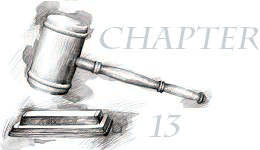Chapter 13 Bankruptcy – Type of Personal Bankruptcy
 Chapter 13 bankruptcy is a type of personal bankruptcy that allows you to set up a structured plan to repay your debts over the course of three to five years. While Chapter 7 bankruptcy requires you to liquidate your assets to settle your debts, Chapter 13 allows you to keep all your property. This type of bankruptcy takes longer to resolve, and you have to give up some of your financial freedom–you must work with a bankruptcy trustee and cannot take out a new loan without his permission. However, this type of bankruptcy allows you to keep your property while settling your debts.
Chapter 13 bankruptcy is a type of personal bankruptcy that allows you to set up a structured plan to repay your debts over the course of three to five years. While Chapter 7 bankruptcy requires you to liquidate your assets to settle your debts, Chapter 13 allows you to keep all your property. This type of bankruptcy takes longer to resolve, and you have to give up some of your financial freedom–you must work with a bankruptcy trustee and cannot take out a new loan without his permission. However, this type of bankruptcy allows you to keep your property while settling your debts.
In order to be eligible for Chapter 13 bankruptcy, all you need is a steady source of income, such as a regular job or regular self-employment income. You can also qualify for Chapter 13 bankruptcy if you receive disability payments.
Overview of Chapter 13 Bankruptcy
It is much easier to qualify for Chapter 13 bankruptcy than for Chapter 7; Chapter 7 has strict limits on income, and you can’t qualify if you make more than a certain amount. However, you must have enough disposable income after paying your bills to enter a structured repayment plan if you want to qualify for Chapter 13 bankruptcy.
There are limits on the amount of debt you may carry in order to file for Chapter 13 bankruptcy. You cannot file if your secured debts are more than $1,081,400. Unsecured debts can’t be greater than $360,475. You also must be current on your tax filings. Before filing for Chapter 13 you need to have filed your taxes, and paid or made payment arrangements for the last four years.
In order to file for Chapter 13 bankruptcy, you must prove that you completed a credit counseling session at least 180 days prior to filing. At your credit counseling session, you’ll learn strategies for improving your financial situation and look at all of your options. If your credit counselor agrees that Chapter 13 bankruptcy is the best option, he or she will encourage you to file.
Filing for Chapter 13 bankruptcy requires you to pay certain debts in full, while you may only partially repay other debts. You must pay all filing fees and administrative costs of filing in full. You also must pay mortgage debts and other priority debts, such as child support and alimony in full. Finally, you must pay secured debts in full if you want to keep the property. If you give up your car or other property, you don’t need to pay the debt in full.
Some unsecured debts may not have to be repaid in full. This depends on your income level and how much disposable income you have left over after you pay secured debts and current bills.
Chapter 13 bankruptcy allows you to take responsibility for your debts without becoming overwhelmed by them. Your repayment plan will allow you to repay your debts in a timely manner and wipe them out, and by the end of your bankruptcy you will feel more financially responsible. Just keep up the new, responsible habits you form during your bankruptcy so that you keep your credit record clean, and you won’t have to face bankruptcy again.
